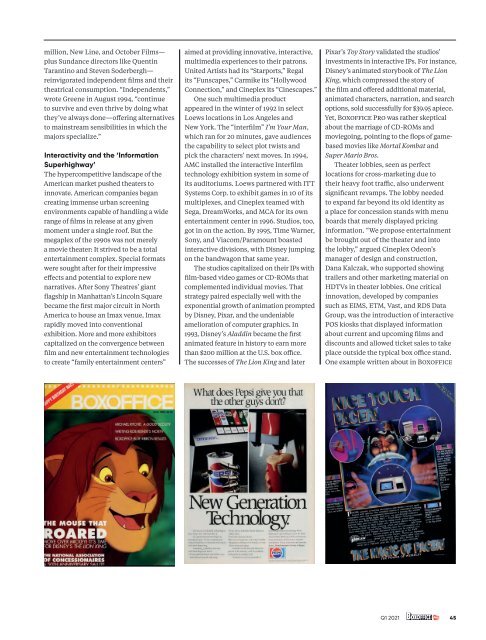Boxoffice Pro Q1 2021
Boxoffice Pro is the official publication of the National Association of Theatre Owners.
Boxoffice Pro is the official publication of the National Association of Theatre Owners.
You also want an ePaper? Increase the reach of your titles
YUMPU automatically turns print PDFs into web optimized ePapers that Google loves.
million, New Line, and October Films—<br />
plus Sundance directors like Quentin<br />
Tarantino and Steven Soderbergh—<br />
reinvigorated independent films and their<br />
theatrical consumption. “Independents,”<br />
wrote Greene in August 1994, “continue<br />
to survive and even thrive by doing what<br />
they’ve always done—offering alternatives<br />
to mainstream sensibilities in which the<br />
majors specialize.”<br />
Interactivity and the ‘Information<br />
Superhighway’<br />
The hypercompetitive landscape of the<br />
American market pushed theaters to<br />
innovate. American companies began<br />
creating immense urban screening<br />
environments capable of handling a wide<br />
range of films in release at any given<br />
moment under a single roof. But the<br />
megaplex of the 1990s was not merely<br />
a movie theater: It strived to be a total<br />
entertainment complex. Special formats<br />
were sought after for their impressive<br />
effects and potential to explore new<br />
narratives. After Sony Theatres’ giant<br />
flagship in Manhattan’s Lincoln Square<br />
became the first major circuit in North<br />
America to house an Imax venue, Imax<br />
rapidly moved into conventional<br />
exhibition. More and more exhibitors<br />
capitalized on the convergence between<br />
film and new entertainment technologies<br />
to create “family entertainment centers”<br />
aimed at providing innovative, interactive,<br />
multimedia experiences to their patrons.<br />
United Artists had its “Starports,” Regal<br />
its “Funscapes,” Carmike its “Hollywood<br />
Connection,” and Cineplex its “Cinescapes.”<br />
One such multimedia product<br />
appeared in the winter of 1992 in select<br />
Loews locations in Los Angeles and<br />
New York. The “interfilm” I’m Your Man,<br />
which ran for 20 minutes, gave audiences<br />
the capability to select plot twists and<br />
pick the characters’ next moves. In 1994,<br />
AMC installed the interactive Interfilm<br />
technology exhibition system in some of<br />
its auditoriums. Loews partnered with ITT<br />
Systems Corp. to exhibit games in 10 of its<br />
multiplexes, and Cineplex teamed with<br />
Sega, DreamWorks, and MCA for its own<br />
entertainment center in 1996. Studios, too,<br />
got in on the action. By 1995, Time Warner,<br />
Sony, and Viacom/Paramount boasted<br />
interactive divisions, with Disney jumping<br />
on the bandwagon that same year.<br />
The studios capitalized on their IPs with<br />
film-based video games or CD-ROMs that<br />
complemented individual movies. That<br />
strategy paired especially well with the<br />
exponential growth of animation prompted<br />
by Disney, Pixar, and the undeniable<br />
amelioration of computer graphics. In<br />
1993, Disney’s Aladdin became the first<br />
animated feature in history to earn more<br />
than $200 million at the U.S. box office.<br />
The successes of The Lion King and later<br />
Pixar’s Toy Story validated the studios’<br />
investments in interactive IPs. For instance,<br />
Disney’s animated storybook of The Lion<br />
King, which compressed the story of<br />
the film and offered additional material,<br />
animated characters, narration, and search<br />
options, sold successfully for $39.95 apiece.<br />
Yet, <strong>Boxoffice</strong> <strong>Pro</strong> was rather skeptical<br />
about the marriage of CD-ROMs and<br />
moviegoing, pointing to the flops of gamebased<br />
movies like Mortal Kombat and<br />
Super Mario Bros.<br />
Theater lobbies, seen as perfect<br />
locations for cross-marketing due to<br />
their heavy foot traffic, also underwent<br />
significant revamps. The lobby needed<br />
to expand far beyond its old identity as<br />
a place for concession stands with menu<br />
boards that merely displayed pricing<br />
information. “We propose entertainment<br />
be brought out of the theater and into<br />
the lobby,” argued Cineplex Odeon’s<br />
manager of design and construction,<br />
Dana Kalczak, who supported showing<br />
trailers and other marketing material on<br />
HDTVs in theater lobbies. One critical<br />
innovation, developed by companies<br />
such as EIMS, ETM, Vast, and RDS Data<br />
Group, was the introduction of interactive<br />
POS kiosks that displayed information<br />
about current and upcoming films and<br />
discounts and allowed ticket sales to take<br />
place outside the typical box office stand.<br />
One example written about in <strong>Boxoffice</strong><br />
<strong>Q1</strong> <strong>2021</strong><br />
45<br />
40-47_CiE-90s.indd 45 12/02/<strong>2021</strong> 12:31

















